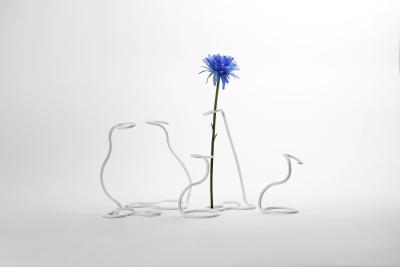5 Papers from Morphing Matter Lab Accepted to CHI 2019

The Morphing Matter Lab from the Human-Computer Interaction Institute at Carnegie Mellon University is presenting five papers at CHI 2019.
A two-color Celtic knot logo is the visual for "Weaving the threads of CHI," the theme of CHI 2019. This is a reflection of the diversity of the human-computer interaction community. "People from different disciplines, cultures, sectors, communities, backgrounds – designers, researchers, practitioners – weaving together into one community, with the common purpose of technology that works for people and society."
Similarly, the work of the Morphing Matter Lab weaves the threads of the behaviors and techniques of morphing matter to envision interfaces of the future.
The idea of morphing matter crosses the boundaries typically associated with the digital and physical worlds, said Lining Yao, assistant professor and director of the Morphing Matter Lab.
“For people often designing with a physical medium, morphing matter adds a flavor of programmability and responsiveness; for those designing with its digital medium, it adds tangibility and sensational experiences. Morphing matter is transforming and mutating. It is an evoking design material as it adds spatial and temporal dimensionality. It reacts, adapts, and evolves; soon it will also grow, replicate, and age. Morphing Matter is ecological. It recapitulates natural organisms, sourcing and reacting to environmental energy stimuli. It demonstrates the reciprocal relationship between the engineered and the grown,” said Yao.
Topics of the five accepted papers include: linear plastic that morphs to 3D when heated; 3D machine knitted objects with sensors and actuator threads already embedded; composite thread that can shrink or twist in response to heat or electrical current; soft and elastic wearable electronics; and morphing continuous double-curvature surfaces or surface textures from 2D to 4D.
Explore each of the five papers with their videos below.
A-line That Transforms into Sculptures, Tools, and Springs
Following up their prior work of leveraging 4D printing of thermoplastic for self-folding, postdoctoral researchers Guanyun Wang and Ye Tao looked to printing 1D linear forms and morphing it into 3D line sculptures once triggered with heat.
The project is named A-line as it transforms from 1D to 3D. Additional authors of the paper include Ozguc Bertug Capunaman and Humphrey Yang, both from the Carnegie Mellon Computational Design program.
Learn more: A-line project info and paper
“A-line: 4D Printing Linear Composite Structures” at CHI 2019.
Led by Guanyun Wang and Ye Tao. Morphing Matter Lab, HCII, CMU
3D Knitting Soft Actuators
Software developed by the researchers from the HCII’s Morphing Matter Lab and Dev Lab (led by Scott Hudson) makes it possible for the objects to emerge from the knitting machines in their desired shapes and with tendons already embedded. They can then be stuffed and the tendons attached to motors, as necessary.
Lea Albaugh, a Ph.D. student who led this research effort, developed the tendon embedding technique in 3D knitting and explored this design space to make lampshades that change shape, stuffed figures that give hugs when poked in the tummy and even a sweater with a sleeve that moves on its own. Although largely fanciful, these objects demonstrate capabilities that could eventually have serious applications, such as soft robots.
Learn more: Knitting Soft Actuators research and paper
“Digital fabrication of soft actuated objects by machine knitting” at CHI 2019.
Led by Lea Albaugh, Morphing Matter Lab and Dev Lab, HCII, CMU
Morphing Threads
ModiFiber is a novel, yet simple and accessible, line-based actuator. It is a twisted-then-coiled nylon thread actuator with a silicone coating. This composite thread actuator exhibits unique two-way reversible shrinking or twisting behaviors triggered by heat or an electrical current (i.e., Joule heating). ModiFiber is soft, flexible, safe to operate and easily woven or sewn, hence it has a great potential as an embedded line-based actuator for design.
The project was lead by Jack Forman from Material Sciences and Engineering at CMU, and joined by interdisciplinary team members including Taylor Tabb from Mechanical Engineering, Youngwook Do from HCII, Meng-Han Yeh from Costume Design and Adrian Galvin from Interaction Design.
“ModiFiber: Two-Way Morphing Soft Thread Actuators for Tangible Interaction” at CHI 2019.
Led by Jack Forman, Morphing Matter Lab, HCII, CMU.
ElectroDermis as the Sensing Skin
Wearables have emerged as an increasingly promising interactive platform, imbuing the body with always-available computational capabilities. This unlocks a wide range of applications, including information access, health, fitness, and fashion. Unlike previous platforms, wearable electronics require structural conformity, must be comfortable and should be soft, elastic, and aesthetically appealing.
ElectroDermis is a fabrication system that simplifies the creation of wearable electronics that are comfortable, elastic, and fully untethered. A future is envisioned where electronics can be temporarily attached to the body (like bandages or party masks), but functional and aesthetically pleasing.
This work is lead by Eric Markvicka from Soft Machines Lab (Led by Prof. Carmel Majidi) and Guanyun Wang from the Morphing Matter Lab and joined by Yi-Chin Lee from School of Architecture, and HCI PhD student Gierad Laput.
Learn more: ElectroDermis research and paper
“ElectroDermis: Fully Untethered, Stretchable, and Highly-Customizable Electronic Bandages” at CHI 2019.
Led by Eric Markvicka (Soft Machines Lab) and Guanyun Wang (Morphing Matter Lab) at CMU
Geodesy for Self-rising Textures
From turtle shells to igloos, textured double curvature surfaces widely exist in nature and architecture. Geodesy geometrically interprets these textured surfaces as a group of raised tiles from a flat or curved continuous surface. These geometries provide many use cases and rich aesthetic qualities.
This work was led by Jianzhe Gu, who collaborated with Prof. David Breen from Drexel University, Jenny Hu and Ty V. Zande from CMU School of Design, Lifeng Zhu and Prof. Jessica Zhang from CMU Mechanical Engineering department, Ye Tao and Guanyun Wang from CMU HCII.
“Geodesy: Self-rising 2.5D Tiles by Printing along 2D Geodesic Closed Path” at CHI 2019.
Led by Jianzhe Gu, Morphing Matter Lab and Computational Bio-Modeling Lab at CMU

